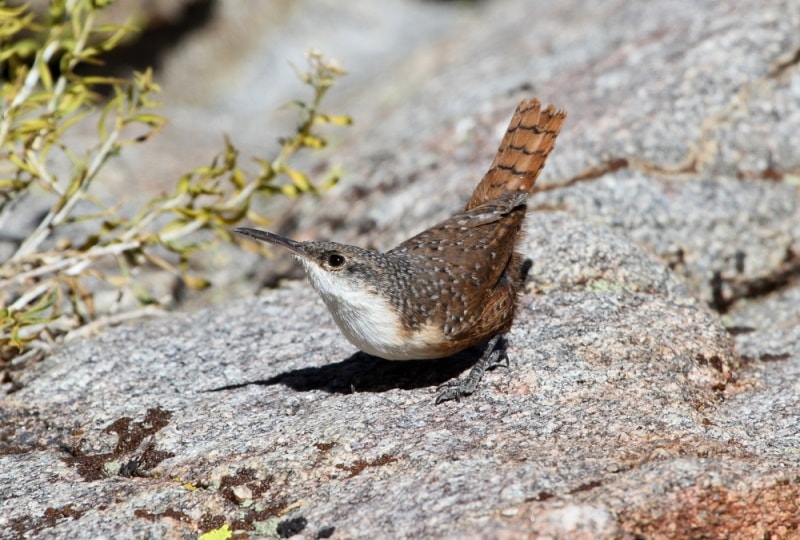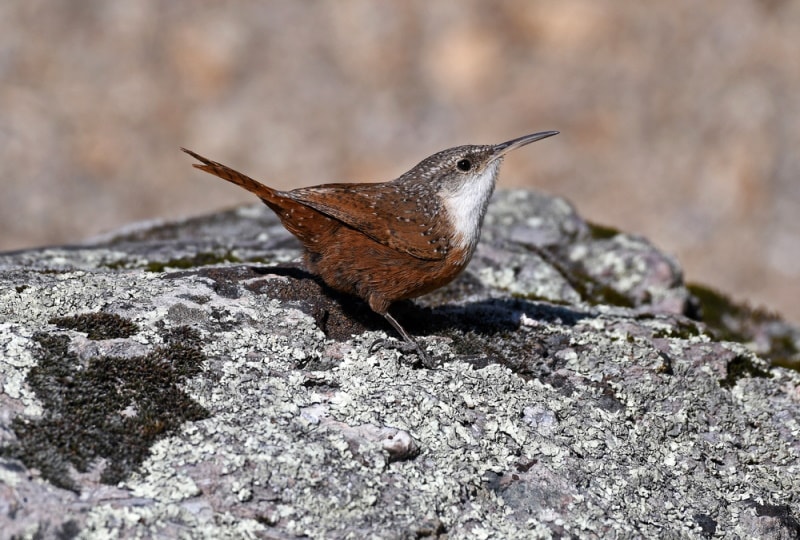Canyon Wren: Field Guide, Pictures, Habitat & Info
Last Updated on

Birdwatching is a challenging hobby that’s equally fun and informative. If you’re new to birdwatching, start with common backyard sightings like the Canyon Wren.
Part of the wren family, the Canyon Wren is one of the most commonly occurring songbirds in the US. Although their appearance is plain, these birds are smart and protective of their territories.
Keep reading to learn more about the Canyon Wren.

Quick Facts About the Canyon Wren
| Habitat | Scrub |
| Diet | Insects |
| Behavior | Foliage Gleaner |
| Nesting | Cavity |
| Conservation | Low Concern |
| Scientific name | Troglodytes Aedon |
| Lifespan | 2 years |
Canyon Wren General Description
The Canyon Wren is a small, brown songbird, with its upper body featuring chestnut plumage and white spots. Meanwhile, its lower body is a rusty brown shade with a black-edged tail fanning out. Its chin, upper breast, and throat areas are bright white.
The brownish-gray head has barely notable white spots leading to a thin, long beak with a sharp edge. The Canyon Wren’s eyes are pitch black, matching their large feet. There’s not much difference between the two sexes, except that the male is larger.
There are two subspecies of Canyon Wren: the Mexican Canyon Wren and Giraud’s Canyon Wren, the former being larger and darker. Their song is loud and sharp, consisting of fluid “tees” and “tews,” followed by strong whistles that descend in pitch. You can hear this melodious song in the Western United States, but their mating call is no more interesting than a metallic buzz.

Canyon Wren Range, Habitat, Behavior, Diet & Nesting
Here’s everything you need to know about this unique bird’s range, habitat, behavior, diet, and nesting.
Range
The Canyon Wren is found throughout the United States, southwards to Mexico and Southern British Columbia. In Southern British Columbia, you’ll find them specifically in the Okanagan Valley. In America, ranges for the Canyon Wren include Western and Southern Idaho, central Wyoming and Colorado, central-Western Texas, Eastern Oklahoma, and Southern Mexico.
Habitat
Canyon Wrens live in cliffs, canyons, rocky areas, arid regions, and boulder piles. You may also find them around stone buildings, but these birds prefer the base of canyon walls above other surfaces. Even though this species doesn’t drink water, they’re often found near water, 9,800 feet above sea level.
After choosing the habitat, the Canyon Wren resides permanently and doesn’t migrate elsewhere. However, it may travel seasonally in search of food. During the winter, some Canyon Wrens prefer to move to warmer areas, such as the Chihuahuan Desert of southwest Texas.

Behavior
The Canyon Wren forages for food by scaling vertical surfaces and clinging to rock walls. These birds can quickly cover short distances by moving at an angle or sideways. Then, as they advance to the oncoming foothold, their rear feet help them secure their position.
Canyon Wrens have swift and decisive movements, such as peeking into crevices for prey, jabbing prey with their sharp bills for extraction, and more. In addition, their flight is impeccable, allowing them to easily chase flying insects and move across canyons.
You’ll find the female Canyon Wren frequently singing during the breeding season. Meanwhile, the males prefer to perch on rocks and sing from spring through summer. When an intruder is around, this bird’s behavior, such as its bows and swings, is similar to a Rock Wren’s.
Canyon Wren mates are seemingly monogamous, staying together for at least a year. Since then, all their activities have occurred together, such as foraging, scaling, migrating, investigating, calling, defending, and more.
Regarding their breeding grounds, Canyon Wrens can get defensive and territorial, protecting 1–4 acres of land. While residing in canyons, both sides of the canyon are also their territory, which they defend relentlessly.
Diet
The Canyon Wren is an insectivore, feeding on insects and spiders found in the canyon’s crevices. That includes leafhoppers, ants, moths, aphids, lacewings, crickets, locusts, termites, wasps, beetles, cicadas, scale insects, antlions, and grasshoppers.
Not only do these birds eat spiders, but they also steal insects from spider webs and wasp nets. The water content in these insects serves enough for the hydration of these birds, which is why they don’t search for water.

Nesting
Canyon Wrens build their nests in any crevices in cliffs, small caves, stone buildings, banks, abandoned sheds, etc. The female and male collaborate equally to build the nest with the help of twigs, dead leaves, grass, moss, lichens, feathers, wool, plant down, and animal hair. They may also cover their nests in debris and spider webs for camouflage.
How to Find Canyon Wrens: Birdwatching Tips
Canyon Wrens are common birds, so it isn’t hard for you to spot them. You must know the essential birdwatching tips, such as what to listen for and when to look.
What to Listen For
While the females prefer to sing only during breeding, the male Canyon Wren will sing from spring through summer. Both sexes have a melodious song, consisting of liquid notes, descending and slowing repeatedly. Often, these notes trail off into double notes or finish with a few mewling calls. Male songs sound richer than the female’s, lasting much longer, and are sometimes even heard in the winter.
What to Look For
When looking for a Canyon Wren, focus on their flight, nesting, and general behavior. Their flight is weak and fluttering but direct, allowing them to travel across canyons. You might note it is making frequent and short trips from rock to rock.
In terms of behavior, look for a bird well adapted to its environment. You might find a Canyon Wren climbing up and down, scaling vertical surfaces, and easy walking across since it has a low center of gravity. It’s often found creeping around walls to attack prey without it knowing.
Canyon Wrens’ cup-shaped nests are found in any crevices or holes. The male may be caught collecting twigs, bark, sticks, and grass for the base, while the female forages for wool, fur, and feather for a soft lining.

When to Look
Canyon Wrens return to their breeding grounds after winter in warmer regions. They may stay in North America from April through July, which is why the summer is the best time to look for Canyon Wrens. You may even find some early arrivals who didn’t spend their winter far from their breeding ground.
Attracting Canyon Wrens to Your Backyard: Tips & Tricks
Attracting Canyon Wrens to your backyard isn’t too hard, as these birds are commonly spotted throughout the US and are tolerant of humans. Here are some tips that may help attract a Canyon Wren to your backyard:
- Like other Wrens, Canyon Wrens love feeding on slugs, insects, and snails, so you may ensure an attractive food source for these birds by minimizing pesticides and insecticides in your backyard.
- Canyon Wrens forage for food by flipping over leaves and stones, so leaving leaf litter in your backyard may make them comfortable enough to search for food.
- Smaller insects on your trees and foliage, such as spiders, gnats, and ants, attract Canyon Wrens, so it’s best to reduce efforts for their removal.
- Fill your bird feeders with earthworms, crickets, mealworms, suet, shelled peanuts, and peanut butter, as these are some of the Canyon Wren’s favorite treats.
- Opt for tray feeders or shallow dishes to allow easy access for the small songbirds.
- Canyon Wrens have trouble searching for winter food sources as most insects have vanished by then, so plant a native berry-producing shrub in your backyard to attract this bird.

Canyon Wren Conservation: Is This Bird Threatened?
Canyon Wrens are not threatened as they are defined as a “Least Concern” species, which means they have a healthy population. However, while these birds are common within their range, they have significantly declined in number in other areas.
For example, they were seen numerously in towns, but other cavity-nesting birds such as House Sparrows have invaded their territories. It’s also worth noting that spring heat waves may endanger young Canyon Wrens in their nests in the future.
•You might also like: Spotless Starling: Field Guide, Pictures, Habitat & Info

Conclusion
Canyon Wrens are much like other birds within the Wren species, but their scaling and foraging skills are much sharper. But attracting them to your backyard is quite easy, especially if you follow our tips. Now that you know everything about the range, habitat, diet, and nesting, you can spot them easily and share their facts with other bird enthusiasts.
Featured Image Credit: A. Viduetsky, Shuttwerstock
About the Author Jeff Weishaupt
Jeff is a tech professional by day, writer, and amateur photographer by night. He's had the privilege of leading software teams for startups to the Fortune 100 over the past two decades. He currently works in the data privacy space. Jeff's amateur photography interests started in 2008 when he got his first DSLR camera, the Canon Rebel. Since then, he's taken tens of thousands of photos. His favorite handheld camera these days is his Google Pixel 6 XL. He loves taking photos of nature and his kids. In 2016, he bought his first drone, the Mavic Pro. Taking photos from the air is an amazing perspective, and he loves to take his drone while traveling.
Related Articles:
10 Types of Hummingbirds in Arkansas (With Pictures)
8 Types of Hummingbirds in Nebraska (With Pictures)
5 Types of Hummingbirds in Idaho (With Pictures)
3 Types of Hummingbirds in Mississippi (With Pictures)
8 Types of Hummingbirds in Kansas (With Pictures)
5 Types of Hummingbirds in West Virginia (With Pictures)
5 Types of Hummingbirds in Ohio (With Pictures)
Where Do Nuthatches Nest? Nuthatch Nesting Habits Explained
